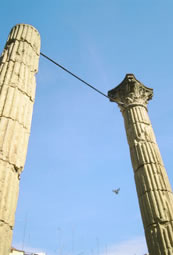
Monastery of Poblet
In 1991, Unesco stated the adhesion of the Monastery of Poblet into the World Heritage list. The reasons were related on the impressive majesty of its infrastructures, such as the abbey and the royal residence, and its historical importance, which is very well represented by the pantheon of the kings of Catalonia and Aragon. The monastery, placed in the region of the Conca de Barberà and dated back of the 12th century, is one of the seniors Cistercian abbeys of Spain. This, together with those of Santes Creus and Santa Maria de les Monges, takes part of the monasteries set which follow the Order of the Cister and were established in the New Catalonia during the second half of the 12th century.The Order of the Cister was born in 1098, when a numerous group of French Benedictine monks decided to leave the Monastery of Molesme in search of a solitary place where meet up with God again and retrieving the authenticity and simplicity of the faith. It took place in Cîteaux (Cister) where they applied the guiding principles based on the Gospel and the Rule of Saint Benedictine in all its purity. From that moment, the religious orders contributed decisively in the medieval European society of the period; Catalonia lived the new period of growth of this religious style from 1150, after wedding of Ramon Berenguer IV and Petronila of Aragon in order to joint the kingdoms of Catalonia and Aragon respectively. From the 12th century, the set of Cistercian monasteries which were established in the New Catalonia began their splendour period. They worked as a reorganization and repopulation instrument for the conquered lands by the Catalan-Aragonese monarchy to the Muslims. In 1835, the trajectory of the monastery was blocked by the Spanish disentailment. With the return of the monks in 1940, Poblet started off an ambitious process of restoration and conservation which has given back to the monastery its old and corresponding majesty.
Santa Maria de Poblet, which name is due to its surrounding poplars ('populetum'), was constructed in different phases, between the 12th and 18th centuries, and depending on the needs of the community. The monastic complex is composed of three precincts which are closed by a 2 kilometres wall. The most interior and hidden area is the monastic space - it is the only non visitable zone of the precinct – and it is placed among the perimeter of the walls of the 14th century. It is possible to access through the Royal Door, which is flanked by two polygonal towers.
On the East zone we can find the most ancient rooms of the monastery. They are perfectly preserved and one of the best examples of the Cistercian monastic architecture. Two of them are the monks’ bedroom, which stands out for its Catalan Gothic style, and the cloister, where is possible to see the perfectly evolution from the Romanesque architectural ways until those of the Gothic world. On the other hand, the church follows a very peculiar floor which has a header with central apse and an ambulatory with five radial chapels. The monastery was the pantheon of the kings of the Crown of Aragon, from Pere el Cerimoniós, and it acquired a great historical importance with the graves of Jaume I, Joan I and Ferran of Antequera.
Approfondimenti
- Rupestrian art of the Mediterranean Arch
- Ancient Roman City of Tarragona
- Monastery of Poblet
|
FORUM
